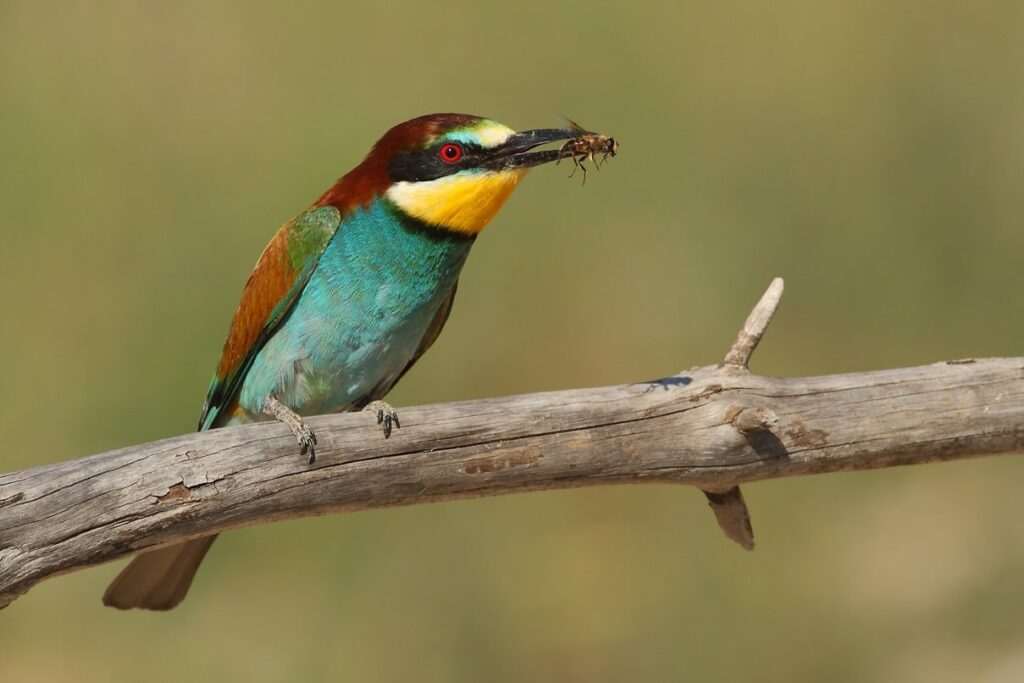If you’re either a beekeeper or a bee enthusiast, you’re probably wondering whether birds pose a threat to their population, right?! Even bird enthusiasts might be asking themselves if bees can sting and hurt birds if they do prefer these insects as prey!
So do birds eat bees, and if so, how exactly do they hunt these small insects, and which species is most adapted to catching this prey?
Birds do eat bees, although not all species are specialized in hunting them. Some birds have more experience in catching bees and, therefore, can avoid being stung. Others prefer eating only bee larvae or beeswax.
If you want to learn what birds eat bees and how this is precisely done, keep reading, as you’re about to discover some fascinating details!
Do Birds Eat Bees?
Since many bird species are omnivorous, they consume both plant matter and insects, bees included.
There are a few species that are specialized in eating bees, while others will only occasionally choose these insects for a meal because they don’t have specific adaptations that allow them to easily catch bees.
First, since bees don’t fly in straight lines, they’re extremely difficult to catch, so birds need to be agile enough and calculate the angle required for successful hunting. Moreover, they have to be experienced in handling bees. Otherwise, they can get stung.

What Birds Eat Bees?
Bee-eaters, part of the Meropidae family, are excellent at hunting, catching, and eating bees, just as their name suggests.
Although bee-eaters have a pretty diverse diet, as they feed on almost any insect they stumble upon, some studies suggest they have a preference for bees, especially honeybees. Specialists proved that the average bee and wasp intake for bee-eaters represents 70%.
As such, it’s only natural that bee-eaters have more experience in catching bees than other species that do not hunt these insects on a daily basis. In fact, some studies show that the more bees a bee-eater catches, the more adapted it becomes to handling it without being stung.
The crested honey buzzard is another bird that often preys on bees. However, it most often goes for the larvae of social bees rather than adult bees. Furthermore, studies show that these birds have specialized feathers on their faces, heads, and necks that provide protection against bee stings.
Since scarlet tanagers have a very diverse diet, preying on almost any flying insect, as well as various fruits, they will also eat bees and wasps. They’re known to scratch the bees against a tree branch to remove the stingers. Only afterward do they delight in their meal.
Their relatives, summer tanagers, won’t refuse a bee meal, too, if the opportunity arises. Most often, they’ll catch them in flight.
The great tit is known to prey on bees and wasps, besides crickets, earwigs, cockroaches, and other bugs.
Here are other birds that have been observed occasionally preying on either adult bees or their larvae:
- Nuthatches
- Woodpeckers
- Fly-catchers
- Mockingbirds
- Swifts
- Orioles
- Northern cardinals
However, even if the species mentioned above prey on bees, it will most likely occur on the ground. In any case, this happens rarely, and the species aren’t a threat to the bee population.
Other birds do not feed on bees for one or more of these reasons:
- They’re not skilled enough to hunt bees.
- Some birds, like sparrows, do not feed on bees because they prefer eating seeds and grains.
- They prefer other insects.
Do Birds Eat Wasps?
Birds eat wasps, too. In fact, most of the species that prey on bees will also prey on wasps as well. If anything, wasps might be easier to catch as they’re slightly larger than bees. As such, birds can spot wasps from afar and have more time to decide on a hunting and catching strategy.
You can have a look at birds that eat wasps.
Do Birds Eat Beeswax?
Only a few world’s bird species delight in a beeswax meal. The most famous beeswax eaters are probably honeyguides, also called honey birds or indicator birds. The honeyguide family, Indicatoridae, includes 17 species, and all feed on beeswax. Besides beeswax, these birds eat waxworms, bee larvae, as well as spiders and fruits.
Are Birds A Threat to Bees?
Yes, birds can represent a major threat to the bee population, especially the species that raid beehives. As such, if you’re a beekeeper, we recommend researching what birds live in your area and taking necessary precautions to protect your colonies. You can use physical barriers to protect them, change their location to a less accessible one, or install some noise-making devices.
